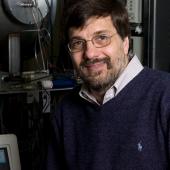Marshall,MarkD
近期热点
资料介绍
个人简历
Ph.D., Chemistry, Harvard University (1985)
“Molecular potential energy surfaces probed by high resolution far-infrared and microwave spectroscopy,”
M.A., Chemistry, Harvard University (1981)
B.S., Chemistry, University of Rochester (1979)
A.M. (honorary), Amherst College (2000)
I am a physical chemist, seeking an understanding of chemical systems through application of the laws and techniques of physics. The courses that I teach reflect these interests by providing Amherst College students with the fundamental tools of chemistry necessary to address questions throughout all areas of scientific inquiry. Brief descriptions of these courses follow. Most recently, I have been teaching (but translated to our new three-digit course numbers) Chemistry 155 and Chemistry 161, but in the past and certainly in the future I have taught and will teach Chemistry 151, Chemistry 351, and Chemistry 361.
Chemistry 151 (Introductory Chemistry): This first course in chemistry at Amherst is concerned with atomic and molecular structure, or how the basic building blocks of matter are put together into the myriad materials of everyday life. Because the physical behavior of light objects confined to small spaces is not a part of routine experience, light electrons, when bound in small atoms, act in unfamiliar ways that cannot be understood by analogies to macroscopic objects. Since classical mechanics fails to account for electron behavior in atoms and molecules, elementary ideas and results from quantum mechanics are introduced.
Chemistry 155 (Fundamental Principles of Chemistry): This course is intended for students entering Amherst with outstanding preparations in chemistry. Although the topics discussed are the same as in Chemistry 151 the approach is markedly different. In my hands, Chemistry 155 is an introduction to chemical physics that focuses on the foundations of our current understanding of chemistry. Topics are treated in greater physical and mathematical detail than in Chemistry 151, and in particular, the application of quantum mechanics to chemical systems is done in a more advanced fashion.
Chemistry 161 (Chemical Principles): Both Chemistry 151 and 155 lead into Chemistry 161 as a second course in chemistry at Amherst. Chemistry 161 is an introduction to chemical thermodynamics and kinetics, both of which are concerned with chemical reactions or changes in molecular structures. The thermodynamics portion of the course addresses the question of the position of chemical equilibrium and the properties of chemical systems that control it. Chemical kinetics investigates the rate at which equilibrium is achieved, or how quickly a reaction occurs. One might say that thermodynamics answers the question, “Where is the reaction going?” while kinetics responds to “When is it going to get there?”
Chemistry 361 (Physical Chemistry): Chemistry 361 expands upon the principles of thermodynamics introduced in Chemistry 161. These are investigated in more detail and the connection between observed macroscopic concepts such as energy, entropy, and equilibrium and microscopic molecular properties is made via statistical mechanics.
Chemistry 351 (Quantum Chemistry and Spectroscopy): Chemistry 351 is an introduction to the fundamental postulates of quantum mechanics and their application to chemical systems, particularly through various forms of spectroscopy. The mathematical tools necessary for a quantum treatment of atomic and molecular behavior are developed.
近期论文
Helen O. Leung, Mark D. Marshall, and Nazir D. Khan,
标签: 阿默斯特学院
相关热点
最新收录
- Marshall,MarkD 09-20
- Loinaz,WilliamA 09-20
- Levin,Rachel 09-20
- Leung,Helen 09-20
- Kushick,JosephN 09-19
- Jeong,Jeeyon 09-19
- Jaswal,Sheila 09-19
- Hood,Michael 09-19
- Hansen,DavidE 09-19
- Graf,Ethan 09-19
- Goutte,CarolineE 09-19
- Clotfelter,EthanD 09-19
- Carter,Ashley 09-19
- Burkett,SandraL 09-19
- Bishop,Anthony 09-19

